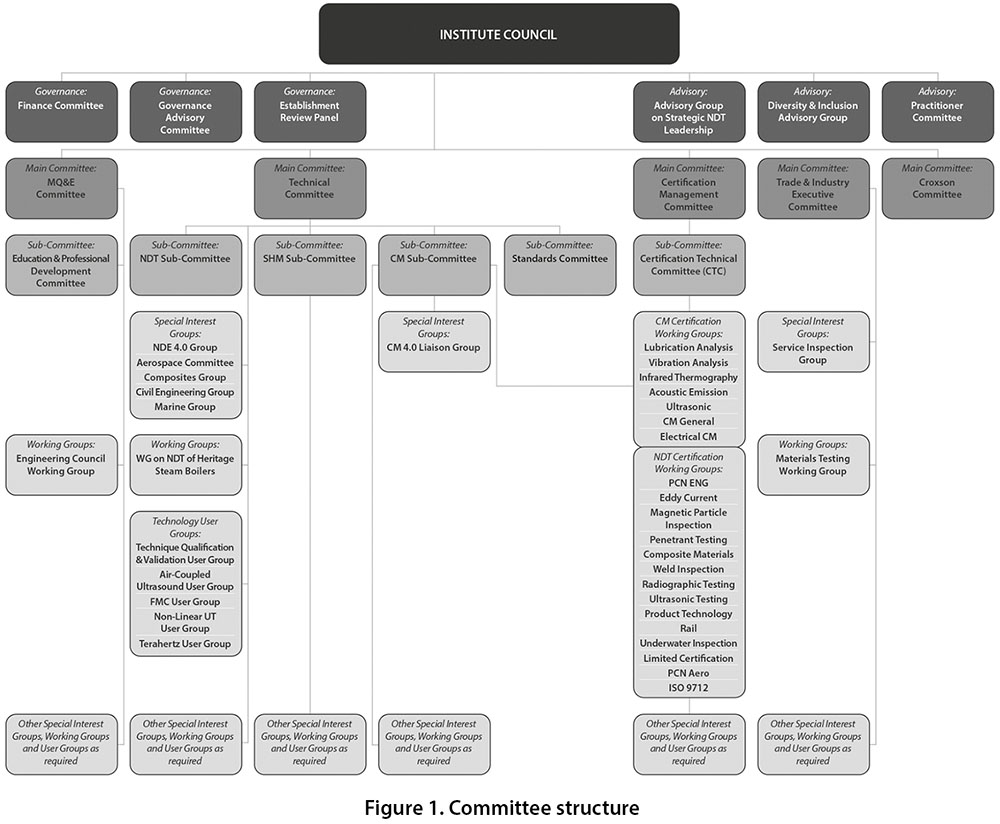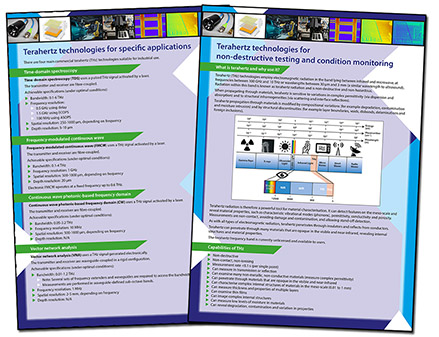User Groups
The Institute has user groups which meet the specific needs of members with particular interests.
Figure 1 shows some of the groups that exist at the time of writing. Further groups may be established as topics arise.

The Institute facilitates a number of user groups focusing on promoting and advancing new technologies, with an aim to share methodologies and recommend standardisation and best practice as appropriate. The specific objectives of each group vary, but can include reviewing existing methods, producing best practice guidelines and agreeing upon standard terminology, recommending formats for data recording and presentation, capturing industry-based studies that showcase the technique, recommending inclusion of the new technique in PCN training courses and producing an overview of the current capabilities of the technique, highlighting advantages and disadvantages and where it may be used in preference to other more established methods.
Current User Groups include:
Membership of all groups is open to members (and in some cases non-members) at no additional charge. Group members benefit from discussion of current topics of interest or controversy and from the interchange of views between individuals all sharing a specific common interest. As a group, they can influence affairs that they couldn’t as individuals.
For further information, contact Cindy Bailey at the Secretariat (cindy.bailey@bindt.org).
The Full Matrix Capture (FMC) User Group The Full Matrix Capture (FMC) User Group of the British Institute of Non-Destructive Testing has been established to promote and advance FMC and associated processing techniques for ultrasonic array data by using standardisation as appropriate and recommending best practice.
The current objectives for the group are as follows:
Organisation The FMC User group shall operate under the Terms of Reference approved by the BINDT NDT Technical Committee. On any issue involving committing BINDT staff, images, or resources the group must make a recommendation to the BINDT NDT Technical Committee. On matters concerning technicalities and documents related to the group topic, the group may make a decision by voting amongst its members.
Membership Membership of the Group is open to anyone who has an interest in FMC or associated techniques for inspection. Neither membership of BINDT nor being based in the UK is a requirement. To join the group and be added to the mailing list, please contact the Chair.
Discussion forum The FMC User Group discussion forum can be found here:
https://fmc-user-group.freeforums.net/
Minutes of meetings
Other documents
The MFMC initiative The multi-frame full matrix capture (MFMC) file format is an open format designed for the storage and interchange of data obtained from ultrasonic array probes. It has been designed specifically for the storage of the original ultrasonic data in its raw form acquired under the paradigm of full matrix capture (FMC), although the format can accommodate other acquisition modalities. The specification for the MFMC common file format is found in the link below:
https://github.com/ndtatbristol/mfmc/releases
Terahertz (THz) User Group The Terahertz (THz) User Group of the British Institute of Non-Destructive Testing has been established to promote and advance techniques utilising THz technologies to inspect components, materials and structures, and to recommend standardisation and best practice as appropriate.
THz technologies refers to all types of instrumentation utilising electromagnetic signal at frequencies between 100 GHz and 10 THz.
The following high-level objectives have been identified as immediate priorities for the group:
Sub-objectives (methods of progress towards the above objectives):
The following additional objectives have also been identified:
The full terms of reference for the THz User Group can be downloaded here.
To view or download a copy of the 'Terahertz technologies for NDT and CM' leaflet, click here.
To view or download a copy of the 'Terahertz technologies for specific applications' leaflet, click here.
To view or download the NDT 2023 plenary presentation, titled: 'Terahertz Sensing for NDE Applications', click here.
The NDE 4.0 Podcast titled 'How Terahertz Technology Will Impact NDE?' has been published on behalf of the THz User Group. To listen to the podcast, click here.
Figure 1 shows some of the groups that exist at the time of writing. Further groups may be established as topics arise.

The Institute facilitates a number of user groups focusing on promoting and advancing new technologies, with an aim to share methodologies and recommend standardisation and best practice as appropriate. The specific objectives of each group vary, but can include reviewing existing methods, producing best practice guidelines and agreeing upon standard terminology, recommending formats for data recording and presentation, capturing industry-based studies that showcase the technique, recommending inclusion of the new technique in PCN training courses and producing an overview of the current capabilities of the technique, highlighting advantages and disadvantages and where it may be used in preference to other more established methods.
Current User Groups include:
- Air-Coupled Ultrasound User Group
- FMC User Group
- Non-Linear UT User Group
- Technique Validation and Qualification User Group
- Terahertz User Group.
Membership of all groups is open to members (and in some cases non-members) at no additional charge. Group members benefit from discussion of current topics of interest or controversy and from the interchange of views between individuals all sharing a specific common interest. As a group, they can influence affairs that they couldn’t as individuals.
For further information, contact Cindy Bailey at the Secretariat (cindy.bailey@bindt.org).
The Full Matrix Capture (FMC) User Group The Full Matrix Capture (FMC) User Group of the British Institute of Non-Destructive Testing has been established to promote and advance FMC and associated processing techniques for ultrasonic array data by using standardisation as appropriate and recommending best practice.
The current objectives for the group are as follows:
- Continue to develop and support the common format for storage of raw FMC data (i.e.) the MFMC initiative, see below)
- Develop a common format for storage of reconstructed data (e.g. images) generated from FMC data
- Review existing techniques for the calibration for FMC inspection and provide a recommendation for best practice
- Share of experience and best practice in qualifying FMC-based inspections
- Review FMC-based training courses / manual to identify gaps and produce a recommended syllabus if necessary
Organisation The FMC User group shall operate under the Terms of Reference approved by the BINDT NDT Technical Committee. On any issue involving committing BINDT staff, images, or resources the group must make a recommendation to the BINDT NDT Technical Committee. On matters concerning technicalities and documents related to the group topic, the group may make a decision by voting amongst its members.
Membership Membership of the Group is open to anyone who has an interest in FMC or associated techniques for inspection. Neither membership of BINDT nor being based in the UK is a requirement. To join the group and be added to the mailing list, please contact the Chair.
Discussion forum The FMC User Group discussion forum can be found here:
https://fmc-user-group.freeforums.net/
Minutes of meetings
Other documents
| Document | Title | |||
| FMC data: How to create a common file format | ||||
The MFMC initiative The multi-frame full matrix capture (MFMC) file format is an open format designed for the storage and interchange of data obtained from ultrasonic array probes. It has been designed specifically for the storage of the original ultrasonic data in its raw form acquired under the paradigm of full matrix capture (FMC), although the format can accommodate other acquisition modalities. The specification for the MFMC common file format is found in the link below:
https://github.com/ndtatbristol/mfmc/releases
Terahertz (THz) User Group The Terahertz (THz) User Group of the British Institute of Non-Destructive Testing has been established to promote and advance techniques utilising THz technologies to inspect components, materials and structures, and to recommend standardisation and best practice as appropriate.
THz technologies refers to all types of instrumentation utilising electromagnetic signal at frequencies between 100 GHz and 10 THz.
The following high-level objectives have been identified as immediate priorities for the group:
- To understand and describe/document end-user requirements for applications that may be solved by THz methods. (Note: each type of application will have different requirements.)
- To manage industrial end-user understanding of the capabilities and limitations of THz technologies, and which technologies suit different applications.
- To identify and document barriers to the introduction of THz technologies in NDT.
- To road-map different THz technologies, including terminology definitions, best practice guides, and current state of maturity in each case.
- To assess technology readiness level and commercial readiness of different THz technologies.
Sub-objectives (methods of progress towards the above objectives):
- Special issues of journals, workshops, seminars, etc.
- Review of state of the art in THz inspection.
- Production of a guide of agreed terminology.
- Recommendation of best practice.
- Recommendation of procedures for component and system specification.
- Recommendation on best format for data presentation and recording.
- Development of a list of the recommended practices against which organisations (i.e. equipment manufacturers) may show compliance.
The following additional objectives have also been identified:
- To provide guidance on electromagnetic simulation methods.
- To build, or reference, a library of THz dielectric properties of materials, available for general use.
- To highlight the advantages and disadvantages of THz inspection, and to provide guidance on when it is worth using in place of other techniques.
- To capture industry-based studies in order to showcase the range of possible techniques.
- To provide best practice for storage of the data (how to deal with data volumes, server, archive, etc.)

The full terms of reference for the THz User Group can be downloaded here.
To view or download a copy of the 'Terahertz technologies for NDT and CM' leaflet, click here.
To view or download a copy of the 'Terahertz technologies for specific applications' leaflet, click here.
To view or download the NDT 2023 plenary presentation, titled: 'Terahertz Sensing for NDE Applications', click here.
The NDE 4.0 Podcast titled 'How Terahertz Technology Will Impact NDE?' has been published on behalf of the THz User Group. To listen to the podcast, click here.